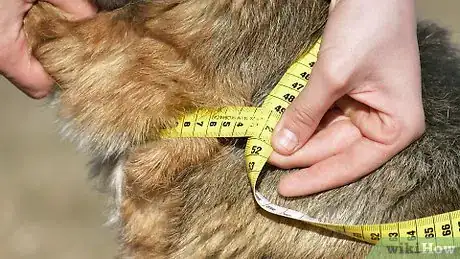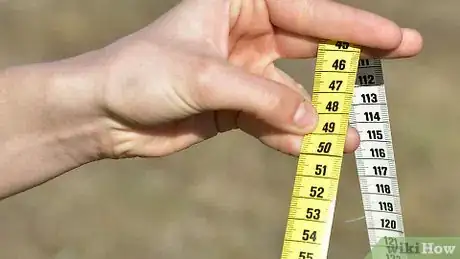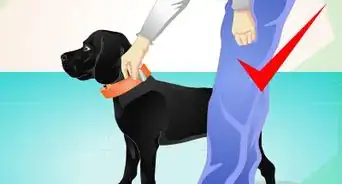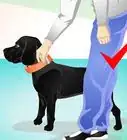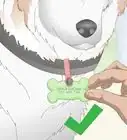This article was co-authored by Ty Brown and by wikiHow staff writer, Janice Tieperman. Ty Brown is a Dog Behaviorist and Trainer and the Owner of Ty the Dog Guy, a business that provides dog training through digital resources (podcasts, web series, and online courses) along with in-person dog training. Ty has over 17 years of experience in dog training and specializes in both mitigating unruly pet behavior and service dog training. Ty has been awarded the "Best of State Award" for dog training in Utah ten times and his work has been featured in ABC, NBC, CBS, Spike TV, and Entrepreneur Magazine.
This article has been viewed 10,634 times.
Collars are essential to a dog’s safety, especially when it comes to walks and other outdoor activities. Thankfully, measuring tape makes it easy to find a perfectly fitting accessory for your furry friend. All you have to do is wrap a flexible section of measuring tape snugly around your dog’s neck, then add 1 to 2 in (2.5 to 5.1 cm) to the total measurement. Once you have the collar in hand, secure it around your dog’s neck to make sure that it’s a good fit!
Steps
Determining Your Dog’s Neck Size
-
1Estimate your dog’s collar size if you don’t want to use a measuring tape. Review some basic information about your pet, such as its breed, height, and weight. Next, compare your dog’s stats to a general measuring guide for collar fitting. Note that many retailers sell collars based on general weight classes.[1]
- Extra-extra-small and extra-small dogs weigh up to 10 pounds (4.5 kg), and need collars that are about 6 to 12 in (15 to 30 cm) long. Pomeranians, Yorkshire Terriers, Dachshunds, Chihuahuas, and Toy Poodles fit into this category.
- Small dogs weigh between 11 and 25 pounds (5.0 and 11.3 kg), and need collars that are between 10 and 14 in (25 and 36 cm) long. Miniature Schnauzers, Corgis, Shiba Inus, and Cavalier King Charles Spaniel qualify for this group.
- Medium dogs weigh between 26 and 55 pounds (12 and 25 kg), and require collars that are between 14 to 20 in (36 to 51 cm) long. Springer Spaniels, English Bulldogs, and some Pit Bulls fall into this group.
- Large dogs weigh between 56 and 75 pounds (25 and 34 kg), and need a collar that’s between 16 to 26 in (41 to 66 cm) long. Most Labrador Retrievers and Golden Retrievers are in this category.
- Extra-large and extra-extra-large dogs weigh over 76 pounds (34 kg), and need a collar that’s between 24 to 30 in (61 to 76 cm) long. Saint Bernards, Great Danes, and Bullmastiffs qualify for this category.
-
2Wrap a soft measuring tape around the base of your dog’s neck. Take a long, flexible measuring tape and loop it around your dog’s neck directly above the shoulder blades. If you aren’t sure where to measure, arrange the tape 3 to 5 in (7.6 to 12.7 cm) beneath your dog’s jaw line.[2]
- The measuring tape in many sewing kits works well for this.
- If you don’t have a soft measuring tape on hand, use a long piece of string or yarn instead.
Advertisement -
3Create a snug loop with the tape around your dog’s neck. Overlap the end of the measuring tape with the rest of the loop so you can get a more accurate measurement for your pet’s collar. Check that the loop is taut without being too tight; in the end, your goal is to find and purchase a breathable, comfortable accessory for your dog. After creating a firm loop, examine the tape to see what your dog’s exact neck measurement is.[3]
- If you’re using a section of string or yarn as a measuring tool, pinch or trim the total length of the loop to use as a reference. Then, you can place this string directly next to a ruler or steel measuring tape to get an exact measurement!
-
4Add 1 to 2 in (2.5 to 5.1 cm) to the total measurement. Before purchasing a new collar, write down the initial measurement of your dog’s neck. If you have a smaller, toy-sized dog (e.g., a Chihuahua, Pomeranian), add 1 in (2.5 cm) to the total measurement. If your dog is medium-sized or larger, add 2 in (5.1 cm) total inches to the initial collar measurement.[4]
- These extra inches or centimeters giving the collar a bit of breathing room, and prevent the accessory from being too tight on your pet.
-
5Measure around the base of your dog’s skull for a specialty collar. Loop your measuring tape around the top of your dog’s neck, arranging it just below the jaw line. Create a snug loop with the tape, then take note of the final measurement. If you’re getting a specialty brand collar, like a Martingale or Tag accessory, you might need to factor in this measurement before making a purchase.[5]
- These types of collars are specifically designed to fit over the middle of your dogs neck, instead of the base. Getting 2 measurements along your dog’s neck help to ensure that the collar fits comfortably.
Types of Specialty Collars
Martingale collars have an extra loop cinch in the front, and provide extra support for dogs with thicker necks and small heads, like Greyhounds.[6]
Head collars go around the muzzle, and are good for large, rambunctious dogs like Golden Retrievers that tend to pull on the leash. Ask a pet supply store associate for help to get an accurate measurement for this kind of collar.
Prong collars fit snugly around the middle of your dog’s neck, and deter your pet from pulling too much. If you’re purchasing this kind of collar, use the initial measurement of your dog’s neck without the extra 1 to 2 in (2.5 to 5.1 cm) added.[7]
-
6Compare your measurements to a retail guide when purchasing a new collar. Visit a pet supply store or check online for reference guides that provide size recommendations for different collars. Scan this guide to see what collar size your dog fits under so you can make a more confident purchase.
- Always use the sizing chart for the business that you’re buying from.
Trying on the Collar
-
1Place the collar around your dog’s neck. Loop the accessory beneath your dog’s jawline, leaving a small gap of space between the collar and the fur. If you’re using a collar with a plastic clip, adjust the cinch until the accessory fits comfortably over your dog’s neck. If you’re using a collar with a belt buckle, adjust the collar until there’s a little bit of wiggle room between the accessory and your dog’s fur.[8]
- Although you want the collar to be tight, you don’t want it to be choking your pet when you take it for a walk.
-
2Fit 2 fingers beneath the collar to ensure that it’s loose enough. Test your pet’s new collar by sliding your pointer and middle finger comfortably beneath the span of the collar. Make sure that only 2 fingers can fit; if you can fit 3 or more fingers beneath the accessory, then the collar is too loose. However, if you can fit fewer than 1 finger into beneath the collar, then the item needs to be loosened.[9]
- Your pointer and middle finger give the most accurate reading on how tight or loose a dog’s collar is.
-
3Select a different tightness setting or collar if the equipment doesn’t fit. Adjust the cinch or belt buckle as needed until the accessory fits your dog more comfortably. If the collar seems excessively loose or tight, try purchasing a different-sized collar altogether.[10]
- While some retailers only sell collars in generic sizes, others sell equipment with more specific measurements. Keep this in mind if you’re in the market for a new pet collar!
Expert Q&A
-
QuestionWhy are you supposed to leash a puppy inside when you first take them home?
 Ty BrownTy Brown is a Dog Behaviorist and Trainer and the Owner of Ty the Dog Guy, a business that provides dog training through digital resources (podcasts, web series, and online courses) along with in-person dog training. Ty has over 17 years of experience in dog training and specializes in both mitigating unruly pet behavior and service dog training. Ty has been awarded the "Best of State Award" for dog training in Utah ten times and his work has been featured in ABC, NBC, CBS, Spike TV, and Entrepreneur Magazine.
Ty BrownTy Brown is a Dog Behaviorist and Trainer and the Owner of Ty the Dog Guy, a business that provides dog training through digital resources (podcasts, web series, and online courses) along with in-person dog training. Ty has over 17 years of experience in dog training and specializes in both mitigating unruly pet behavior and service dog training. Ty has been awarded the "Best of State Award" for dog training in Utah ten times and his work has been featured in ABC, NBC, CBS, Spike TV, and Entrepreneur Magazine.
Dog Trainer There are a few reasons for this. First, it teaches your puppy that they need to stay where you are. Second, it helps to build a bond with your puppy and enforces a boundary. Third, your puppy probably won't be house-trained when you take them home. If they're on a leash, you can pick them up and take them outside if they start to use the bathroom indoors. If they aren't leashed, they may wander out of view, use the bathroom, and then think it's okay to do that.
There are a few reasons for this. First, it teaches your puppy that they need to stay where you are. Second, it helps to build a bond with your puppy and enforces a boundary. Third, your puppy probably won't be house-trained when you take them home. If they're on a leash, you can pick them up and take them outside if they start to use the bathroom indoors. If they aren't leashed, they may wander out of view, use the bathroom, and then think it's okay to do that.
Warnings
- If your dog tends to pull on the leash during walks, consider investing in a harness for exercise-related activities. If a dog pulls on the leash too much, the collar could put extra pressure on the trachea and do long-term damage.[11]⧼thumbs_response⧽
Things You’ll Need
- Soft measuring tape
References
- ↑ https://www.caninejournal.com/neck-size/
- ↑ https://www.flyingdogcollars.com/pages/measuring-your-dog
- ↑ https://www.flyingdogcollars.com/pages/measuring-your-dog
- ↑ https://www.flyingdogcollars.com/pages/measuring-your-dog
- ↑ https://www.flyingdogcollars.com/pages/measuring-your-dog
- ↑ https://therapypet.org/blog/martingale-collars/
- ↑ https://www.caninejournal.com/dog-collars-and-leashes/
- ↑ https://www.extension.purdue.edu/extmedia/as/as-564-w.pdf
- ↑ https://www.caninejournal.com/neck-size/

